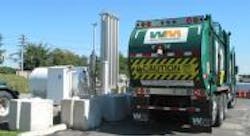“The ability to use recovered landfill gas to fuel our hauling fleet offers significant environmental benefits to the communities we serve in California and is a great example of how we are committed to recovering resources in waste.” –Duane Woods, senior vice president for Waste Management’s Western Group
One of the most enticing alternative fuel concepts these days is the conversion of the methane produced by rotting landfill trash into liquefied natural gas (LNG) that can, in turn, power a variety of heavy trucks.
Refuse companies have worked for years to make this concept a reality and it’s not hard to understand why. I mean, they get paid by consumers and businesses alike to haul away the very trash that could in turn be processed at their very own landfills into the fuel powering the trucks picking up the garbage in the first place.
“Basically, your landfill becomes your own little Saudi Arabia,” David McKenna, product marketing manager for engines, transmissions and axles for Mack Trucks, told me a few years ago. “And when diesel fuel is costing $2.40 to $2.80 a gallon, it suddenly becomes much more economical on a long-term basis to be able to make your own fuel.”
Waste Management is one of those refuse companies that’s worked hard over the years to try and find a way to economically produce fuel from the waste gas given off by their landfills (while also working with Mack to fine-tune LNG-powered refuse trucks along the way).
Now it seems WM may have finally made it happen. Working in partnership with Linde North America, part of The Linde Group, WM recently opened a landfill gas collection and refining plant at its Altamont Landfill near Livermore, California.
The plant, which Linde built and operates, purifies and liquefies landfill gas that WM collects from the natural decomposition of organic waste in the landfill. The plant is designed to produce up to 13,000 gallons of LNG a day – enough to fuel 300 of WM’s 485 LNG-powered waste and recycling collection vehicles in 20 California communities. Since the commissioning process began in September, the Altamont plant – currently the world’s largest landfill gas (LFG) to liquefied natural gas (LNG) facility – has produced 200,000 gallons of LNG, WM said.
[A video clip about this novel LFG-to-LNG facility is below.]
“The Altamont LFG-to-LNG facility enables us to recover and utilize a valuable source of clean energy in another practical way, reducing our dependence on fossil fuels,” said Duane Woods, senior vice president for Waste Management’s Western Group. “We’ve been working for 8 years to achieve this. Landfill-gas-derived LNG is a super ultra-low carbon fuel, as designated by the California Air Resources Board (CARB) and the Altamont project is expected to reduce carbon dioxide (CO2) emissions by nearly 30,000 tons a year.”
[It should also be noted that four California agencies contributed to the $15.5 million WM/Linde project, including the California Integrated Waste Management Board, CARB, the California Energy Commission and the South Coast Air Quality Management District – significantly lowering the research and development cost burden for WM and Linde.]
While WM’s Altamont plant marks the first step in using landfill gas to ultimately power vehicles, it’s not the first – nor the last – such effort to create usable energy from landfill waste.
Back in 2005, SC Johnson added a landfill-gas powered turbine to its largest manufacturing facility, the 2.2 million-square-foot Waxdale manufacturing plant in Racine, WI, to help it generate a total of 6.4 megawatts of electrical power, while also recovering heat from the turbines' exhaust to produce nearly 40,000 pounds per hour of plant steam to help heat the facility.
SC Johnson embarked on the co-generation plan in 2003 with the start up of the first turbine, powered solely by waste methane. After its first year of operation, Waxdale's emissions of carbon dioxide and other greenhouse gases (GHGs) dropped 47%, while fossil fuel energy declined by 50%.
“The second turbine will reduce our greenhouse gas emissions by an additional 20,000 tons per year, bringing total emissions reductions from the co-generation system to 52,000 tons per year,” said Scott Johnson, SC Johnson’s vice president of global environmental and safety actions. “That's equivalent to the amount of GHGs generated by 5,200 automobiles annually.”
[Below is a fun little video about how this “co-generation” process works at the Waxdale facility.]
Indeed, WM has been operating such LFG-to-electricity plants for some time now, operating 108 of these plants nationwide, including three alone in the Dallas/Ft. Worth (DFW) area. All told, these facilities provide the equivalent of nearly 500 megawatts of electricity – enough to power more than 400,000 homes, which is the equivalent to saving nearly seven million barrels of oil per year.
The process to convert landfill gas to energy is fairly simply, explained WM. It begins with the disposal of organic-rich solid waste into a landfill. As the waste decomposes, gas is produced and recovered by a series of extraction wells placed into the landfill. The wells are interconnected by a common collection system that transports the gas to a compression facility. There, the gas is processed to remove moisture before being delivered as fuel to an internal combustion engine, which drives a generator to produce electricity or a truck that picks up trash.
Though this is only a first step down the particular alternative fuel path, it’s nonetheless a pretty exciting one – and may be but one reason some experts believe oil demand is not only going to go down and stay down in the future, but may become less pricey as well. But, again, this is only the first of many steps – we’ve still got a ways to go to making landfill gas a consistent and reliable source of vehicle fuel.
